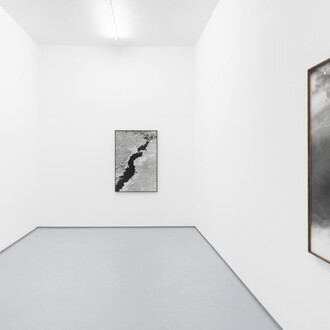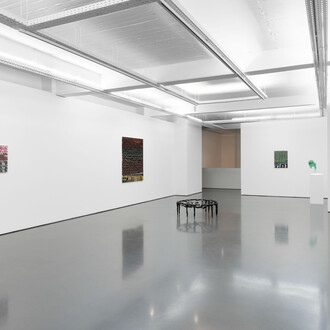The creation of pictorial images that stem from reality and which draw their deepest meaning from it, often occurs, as a pretext for recreation and reflection about the pictorial language: this is what happens here.
The stairs are not directly represented, they are seen in the projection of shadows of stairs and handrails and release themselves in space evoking the steps that created them, but gaining freedom in the most unexpected directions. This is, by the way, a good metaphor of painting: to find a reason that imposes itself, so that, just after a while, it becomes a memory that the slow construction of paintings slowly overcomes; challenging us through transparencies, colours, harmonies and contrasts, questioning us through the sharp limits of a surface or the organic texture of a plane.
The stairs which are at the basis of these works are the stairs in my childhood home, a peculiar drawing that I got used to see every day, and to which I now return, after some years; to observe and consider in different moments of representation.
A staircase appeared at the end of the last exhibition held at Alecrim50 gallery, Uma presença silenciosa (A silent presence), in 2012, and this is the starting point for the work now shown in SCALA. The act of painting implies a commitment and a surrender involving a slowing down of time, repeated gestures which evoke other gestures, by authors that thought about the same questions in the past, as in the labyrinthic staircases of Piranesi, creating spaces of reclusion and existential roaming, as in the impossible constructions of Escher, in the free staircases of Beuys and Louise Bourgeois, in the staircase of Dürer, in Melancholy I, or, in contemporary art in the staircases in Anselm Kiefer works.
The Nude descending a staircase, by Duchamp and all the reinterpretations done by Richter reminds us of the possibility of displaced plans and a certain idea of duration (Bergson). That is a question I return to in these works, through compositional solutions by playing with little time variations of the shadows, superposition and dragging. Dragging that acquires a double meaning: the act of painting but also the effect of dragging time that painting evokes and that was, curiously, made evident by photography in the pioneering work of Muybridge, Étienne-Jules Marey and Bragaglia.
Domingos Rego
Azeitão, 12/4/2015
About Domingos Rego
Born in Castelo Branco, in 1965. Lives and Works in Azeitão and Lisbon.
Degree in Interior Design and Furniture at Escola Superior de Artes Decorativas - Ricardo Espírito Santo Silva Foundation (1987). Degree in Visual Arts – Painting (1994), at FBAUL. Master in Painting, at FBAUL (2006). PhD in Visual Arts / Drawing, at FBAUL (2013).
Coordinates and teaches in the Drawing department, at Escola Superior de Artes Decorativas - Ricardo Espírito Santo Silva Foundation, from 1994 to 2002.
Between 2002 e 2005 was Guest Assistant Lecturer, at FBAUL, in Introduction to Visual Arts and Design, and Painting I. From 2006 becomes Assistant, in Drawing I and Drawing II. From 2013 is Assistant Professor, at the same University, participating in research at CIEBA, Centro de Investigação em Belas-Artes.
















